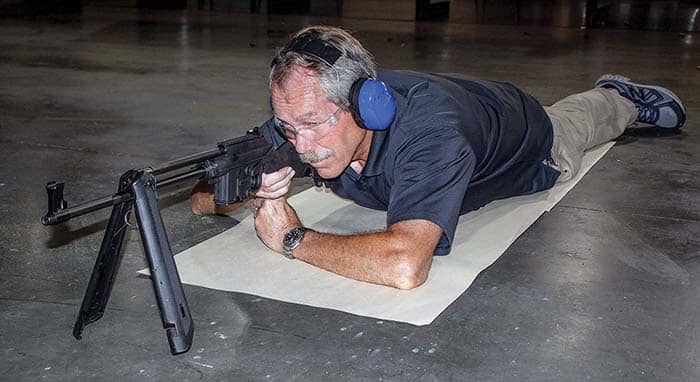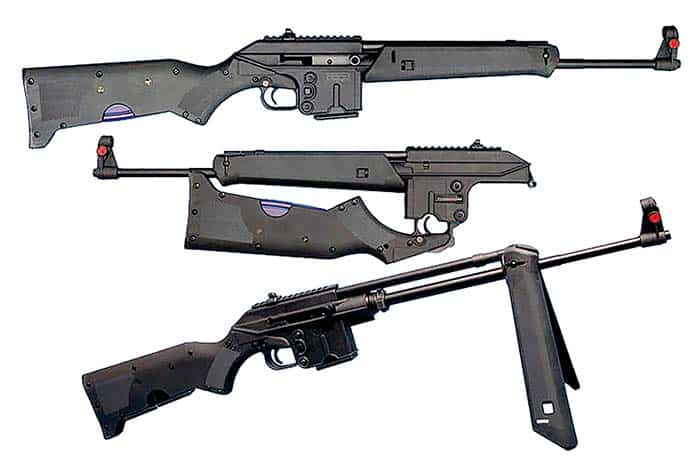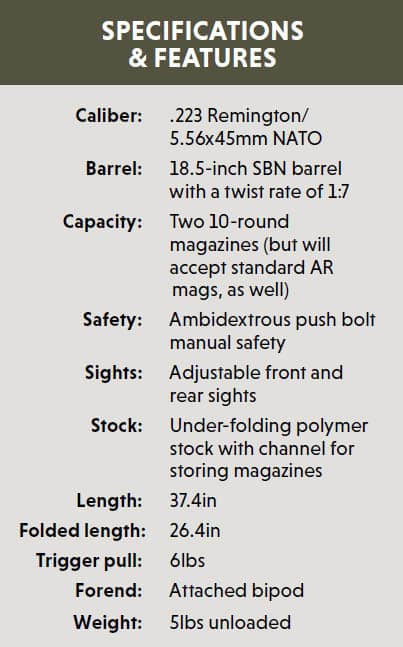By Tara Dixon Engel

Some are quick to dismiss the Kel-Tec brand as “utility guns” (as if that is a bad thing). And, admittedly, the Florida-based manufacturer isn’t necessarily focused on perfecting the gleaming, pimped-up look that some shooting enthusiasts fawn over. But it’s a mistake to dismiss the practicality and innovation that founder George Kellgren has worked hard to foster through the years.
For instance, Kel-Tec led the charge of the “mouse gun” back in the early 2000s with the tiny and innovative P-3AT, which was copied ad nauseum by legions of other manufacturers. The company got even more creative with the advent of the KSG, a truly one-of-a-kind shotgun featuring dual magazine tubes that hold 13 3-inch shotgun shells. Then there’s the funky-looking but wildly popular PMR-30. Indeed, if Kel-Tec is guilty of any sin, it’s not being able to keep up with the popularity of Kellgren’s innovative designs (a problem most manufacturers would love to have).
Brother Arms
The company tackled the outdoorsman/survivalist/“prepper” market with the introduction of the SU-16 back in the early 2000s. If you are looking for a durable, dependable and lightweight gun that can be toted through all terrains and conditions, the SU-16 continues to be worth a second look. The gun is chambered for .223 and 5.56 NATO rounds, and if you want a practice version that won’t drain your ammo budget, the SU-22 replicates the design of the 16 while feeding the more affordable .22 LR round. The .22 version is also ideal for beginners or young people who aren’t quite ready for grown-up recoil.
Shooting at 50 yards on an indoor range, the gun is undeniably loud—Kel-Tecs aren’t known for being delicate or quiet; they are rough-and-tumble and in-your-face—but very effective. Maybe a tad more recoil than some AR-style rifles but still perfectly comfortable to use, even for a gal who typically prefers handguns.

Although the gun features a Picatinny rail for a scope or red dot, the aluminum sights were great. We shot two different 16s, one brand new out-of-the-box and the other well-used. One had a peep sight with a standard M16 post and the other featured a peep sight and fiber-optic blade. Both were highly visible, even for a couple of “old folks” with less than 20/20 vision. The sights are fully adjustable: The M16 post can be adjusted by pressing the detent with the tip of a .223 or 5.56 round; while the fiber optic version requires a Phillips screwdriver.
Inspect the Bore
The only real problem I encountered with the SU-16 is a cautionary tale, not for Kel-Tec users but for anyone pulling a new gun out of the package for the first time. On my initial visit to the range, I had three folks lined up to shoot the gun, which had been pulled brand new from its shipping box. Each time we loaded the magazine and grabbed the charging handle, we’d get a misfeed. Each of us, in turn, attempted to load the weapon. We examined the mags, peered into the chamber, made sure the ammo was compatible and even tried an AR mag (the SU-16 is designed to accept standard AR mags, yet another bonus). When that failed, we set the gun aside and shot its little brother, the SU-22.
But I was plagued by the failure. I knew these to be good, durable guns and I hated to go back to Kel-Tec and ask for “one that works.” Several days later, after borrowing a functional model from a friend, I sat down with both guns, hoping to figure out why one worked and the other didn’t. As I peered around the new gun with a small flashlight, the light caught something orange nestled in the bore about an inch from the breech. I looked twice, trying to figure out what I was seeing … yep, it appeared to be orange plastic. Opening the cardboard storage box, I discovered the safety flag with its stem missing! Somehow it had broken off, probably during shipping. I hadn’t noticed the busted flag as I put the gun together, and the stem had been shoved just deep enough into the bore that you had to really work to see that flash of orange. Thankfully, it was close enough to the breech that it prevented us from chambering a round. Had we been able to do so, and then attempted to fire the gun, it might have been a very bad day on the range. To remedy the obstruction, I ran a cleaning rod from the muzzle toward the chamber and the two-inch stem popped out, rendering the gun completely functional.
This is a good reminder to always inspect your bore before putting ammo through it, especially with a brand new gun. I should have known better. I spent more than enough time behind a gun counter listening to newbies whine “it’s broken,” only to discover they had failed to complete some essential step in new gun break-in. Guess this was my comeuppance for all the times I rolled my eyes and pointed out the obvious.
The Firing Line
With both my SU-16s in fine form, and a spare SU-22 for some plinking fun, I spent time on the firing line with retired Sheriff’s Deputy and former academy instructor John Falldorf, a fan of the Kel-Tec brand.
“These guns are durable and designed for a variety of conditions and situations,” he explained. “It’s tough to damage this gun, but, if you do, one of my favorite things about Kel-Tec is their service and repair. Some manufacturers make you wait 6–8 months before they fix your problem. Kel-Tec’s turnaround is extremely good, and they are always eager to make things right.”
He praised the form and function of the SU-16, pointing out that, weighing in at just 5 pounds, the gun is ideal if you are hoofing through the woods. “With a folding stock, that reduces the length to a little over 26 inches; the gun’s designed to shove into a backpack or sling over your shoulder with minimal added weight,” he explained.

Both guns we shot were A models with 18-inch barrels, but the SU is available in several variations, most notably the CA model, with a 16-inch threaded barrel; the C model, also with the threaded barrel and a skeletal folding stock that allows you to shoot from the folded position; and the E model, which has a more standard AR look, including a telescoping stock and a polymer handguard with accessory rail. Previously produced with chrome barrels, Kel-Tec began using salt bath nitride (SBN) on the SUs in 2012, which offers a higher level of corrosion resistance.
Between the two SU-16s, we encountered only one misfeed (in the new model) as we sent rounds downrange into a hostage scenario target. I am happy to say the hostage lived … with nice, neat patterns about an inch across going into the perp’s torso and head. But, like most guns, the SU-16 does, typically, have a break-in period. Fellow shooters have reported periodic misfeeds up to about 150 rounds, when everything smooths out and the gun becomes, as one enthusiast described it, “one of the most reliable rifles I’ve ever owned.”
Functional Features
Deputy Falldorf pointed out the innovative forend, which converts into a bipod, offering the chance to do some prone distance shooting.
The bipod took a couple of tries to master, but once you get the hang of it, it’s ingenious. The two locking tabs are attached to a ring that encircles the barrel. Gently pull down with two fingers and the bipod spreads its wings. To return it to its folded position, simple push forward slightly on the bipod wings as you return them to the barrel, and the locking tabs will snap into place.
From a recoil standpoint, I was pleasantly surprised. The 16 gives you a firm nudge but nothing that left me looking for a shoulder bruise and nothing that impacted my ability to recover for a follow-up shot. With small hands, I felt like I was stretching a bit to get the pad of my finger squarely on the trigger, but I was nonetheless able to depress the 5–7-pound trigger and keep my finger on it as it reset. The mag release button is easy to use, although the polymer/plastic mags don’t always pop out of the mag well without some coaxing; same is true when retrieving them from their storage channel in the stock; a minor inconvenience, at worst. The charging handle on the right also does a nifty job of deflecting flying casings and is attached to the bolt, which moves it back and forth during firing. By accident, we discovered that you can lock the bolt open by depressing a button located at the rear of the mag well.
It was a very simple gun to use and understand, even for someone who is primarily a handgunner.
“The great thing is that it’s consistent with every other AR-15 platform I’ve ever shot,” Falldorf noted. “That’s especially good because, at around $600, it’s much cheaper than many of your ‘high-end’ ARs and just as functional, even more so with the benefit of the folding stock and attached bipod. It’s also cool that you can carry two fully loaded 10-round mags in the stock.”
The SU-16 is also piston-operated, something you usually see in more expensive AR platforms. Unlike the gas impingement versions, piston-operated guns tend to run cooler and cleaner in the chamber. Chalk up another point for the Kel-Tec engineers.
Add an SU-22
Once we finished putting the 16s through their paces, we ran some rounds through the economical SU-22. The feel was very similar and, of course, there was virtually no recoil, courtesy of the soft-shooting .22 LR rounds.
While I tend to think of the .22 AR styles as being more for beginners or kids, Deputy Falldorf sees the value in having one on hand, no matter one’s skill level.

“If you already own an SU-16, then having an SU-22 just makes sense. Ergonomically, it’s pretty much the same, so you can refine your skill with function drills, trigger press and sight alignment practice for a fraction of the ammo price,” he said.
There is no bipod on the SU-22, however.
All in all, my time spent shooting the SU-16 and its little brother confirmed everything I had read and heard about this durable weapon—and everything I already knew about Kel-Tec’s innovative approach to firearms. Best of all, I now have something to add to next year’s Christmas list.

| This article first appeared in Small Arms Review V23N3 (March 2019) |











